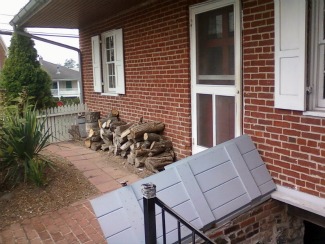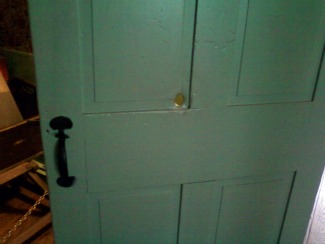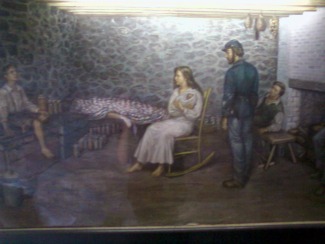Mary Virginia "Jennie" Wade

Mary Virginia [Jennie] Wade was born on May 21, 1843 in Gettysburg, Pennsylvania at her home located on the corner of 105 S. Washington St. and the crest of Baltimore Street, according to an article posted in the Gettysburg Times by Matthew Major. She was the daughter of James Wade, Sr. a local tailor, and Mary Ann Filby Wade. Jennie also had an older sister, Georgiana "Georgia" Wade born July 4, 1841, and three younger brothers, John "Jack" James born March 13, 1846, Samuel Swan born August 6, 1851, and the youngest, Henry Marion who was born February 4, 1855.
Jennie's Childhood Years
"Jennie" as she was later referred to by family and friends attended the local schools in Gettysburg along with her sibling, as well as service at the Trinity Reformed Church in Gettysburg. Growing up, Jennie worked hard helping her parents in their tailoring shop, as well as keeping up with the housework and sewing in her spare time. But when her father became sick in the late 1850s, Jennie's mother and sister took over the seamstress business in order to keep their house on Breckinridge Street.
Jennie Wade's childhood years before the war were also spent playing in the fields and farms around Gettysburg with childhood friends Johnston "Jack" Hasting Skelly and John "Wesley" Culp. Many family members and friends believe that this was the time when Jennie and Jack's friendship blossomed into romance.
Family Hardships
Not only was James Wade's health failing, sometime later, Jennie's father James was arrested for taking three hundred dollars which he found on the ground, money that had fell out of a local Gettysburg man's pocket. Back then, if someone found money on the ground, they were to place an ad in the newspaper and request proof of ownership of that money. It was highly improper to just play finders keepers with lost money.
The money happened to belong to a man named Samuel Durbbraw. And when James Wade was caught leaving the state and traveling over the Maryland line, he was arrested in Washington City by a constable with Mr. Durbbraw present, for the possession of the lost money. When learning of her husband's arrest, Mary Ann Wade, Jennie's mother, petitioned the Adams County Court of Common Pleas to have her husband declared legally insane. This story was featured in a September 2, 1850 issue of the Adams Sentinel found in the archives at the Adams County Historical Society.
The Beginning of the Civil War
When the war first began in 1861, Jack Skelly enlisted in the military, as so did his oldest brother, Charles, as well as childhood friend Wesley Culp. Jennie's oldest brother, John, who at the time was 17, enlisted in the Union Army in June of 1863. In the meanwhile, back in Gettysburg, the tenth New York Cavalry Regiment, was first ordered to Gettysburg. Jennie Wade, her mother, and siblings spared their time repairing the soldier's uniforms and helping out wherever they could, highly respected by the soldiers.
Friday, June 26th, Confederate General Jubal A. Early and his men entered the town of Gettysburg from Chambersburg Street. At this time, Jennie's mother Mary made her way north to stay with Jennie's older sister, Georgia, and Georgia's newborn son, leaving Jennie in charge of their house on Breckinridge Street. Along with keeping watch over the house, Jennie had to care for her youngest brother Harry, and a six-year-old cripple boy, Isaac Brinkerhoff, who was a boarder taken in by the Wades in need of some extra income.
Jennie's Brother Captured By Enemy Soldiers
On that same morning, Jennie Wade's 12-year-old brother Samuel, was living with and working for, at the time, James Pierce, a local butcher. Samuel, a delivery boy for Pierce, was a member of a semi-military group called "The Gettysburg Zouaves." James Pierce ordered young Samuel to go around and gather up all of his horses. One particular favorite service horse of Pierce's was to be taken out of town via Baltimore Street, where it would be out of rebel sight. Unfortunately, Samuel never made it that far. He was captured by enemy soldiers and arrested on the spot.
When learning of her brother's arrest, Jennie quickly came to the aide of her sibling to have him released, but when the captors failed to do so, she then went to her mother to resolve the issue. Mary Ann Wade marched right to General Early, the enemy captor, and demanded the release her son at once. The enemy captors agreed, and once Samuel wade was released, he spent the remainder of the war in James Pierce's basement cellar.
The Cellar Where Jennie's Family Spent the Remainder of the Battle

Jennie Wade and her family never even considered fleeing the town of Gettysburg during the war. Instead, Jennie, her younger brother, and the cripple boy whom they were looking after, decided that their home on Breckinridge was no longer safe, with forces closer to town, and went to a safer haven at Jennie's sister Georgia's house on Baltimore Street.
At her sister's two-story brick duplex house, Jennie kept busy doing chores around the house as well as feeding soldiers and filling their canteens with water, as her mother stayed inside and took care of Jennie's sister and newborn child. As the defeated enemy troops made their way down through town on the first day of battle, Jennie stood alongside the road to offer fresh baked biscuits and water to the tired men.
The battle raged on. The war was moving closer to the home which occupied Jennie, her mother, sister and baby, her brother, and the cripple boy, Jennie's mother moved Georgia's bed downstairs in the parlor so that she could keep a closer eye on her and the baby.
The 10-Pound Shell That Came Crashing Through Georgia's Roof

On the morning of July 2, 1863, shots rang closer and closer to the house. Overall, Georgia's home was hit by more than over one-hundred-and-fifty times. Somewhere from over two miles away along Oak Ridge, a ten-pound shell hit the roof of the two-story brick home, passing through the roof, into the plaster dividing wall separating the two residences, and finally embedding itself into the far wall on the south side of the house. Fortunately, the Parrott Shrapnel did not blow up.
For now, the family considered themselves very lucky. It wasn't until Friday morning on the third of July that the Wade family would witness grief devastation. That morning, numerous bullets struck the sides of the house, busting out all of the windows in the parlor. One bullet even came through the window, struck the bedpost, hit the mantel, and then bounced off landing on the pillow at the foot of Georgia's bed.
The Fatal Bullet Holes

This tragic morning, like every other morning, Jenny Wade woke up early and began preparing biscuits for the soldiers. An infantryman, possibly from Louisiana or maybe a Union marksman, set posted from an occupied house somewhere on the other side of Baltimore Street further up north, fired off shots. One of those shots in particular, passed through the outside kitchen door of Georgia McClellan's home, went through the door between the kitchen and the parlor, and struck Jennie wade in the back left shoulder blade piercing her heart and killing her instantly.
At this time, Jennie's sister Georgia screamed at the top of her lungs upon hearing their mother say that Jennie was dead. Federal Soldiers ran into the house from all directions to see what was wrong. The soldiers instructed that the ladies go immediately into the cellar on the other side of the house where it would be safer. However, actually getting to the cellar posed a problem.
Jennie Wade's mother refused to leave her daughter's body behind. So the soldiers wrapped Jennie's lifeless body in a quilt that her sister made, and proceeded to carry her up the stairs. Mary Ann Wade, followed by her children, made their way up the stairs to the bedrooms, followed by the soldiers who were carrying her daughter's body. Everyone then climbed through the hole that had been blown into the wall from the shell the day before. The hole was made larger by the soldier's who kicked it open wider to fit Jennie's body through. Everyone made their way down the other flight of steps on the opposite side of the house, and out the kitchen door of Georgia's neighbor's house.
Once outside, the group made their way into the cellar where they would spend the remainder of the day and night until the war was over. Jennie's lifeless body was placed on a wooden bench in the back left corner of the basement. For the next 18 hours, Jennie's family and the Federal soldiers sat and waited for the battle outside to subside.
The Wade Family Holds Vidual in the Cellar

When the battle was finally over with, Jennie's body was placed in a wooden casket that had been prepared for a soldier, and was laid to rest in the garden behind her sister’s house for the next six months, until it was later moved to the cemetery nearby the German Reformed Church. Nearly two years after the Battle of Gettysburg, Jennie's sister, Georgia, her husband Louis, and the oldest brother, John, moved Jennie's body to the Evergreen Cemetery.







